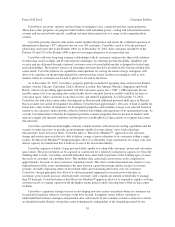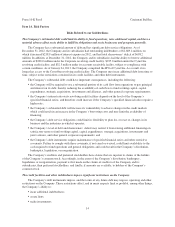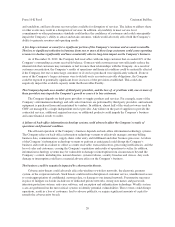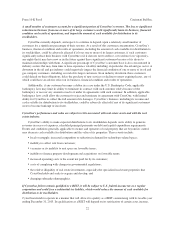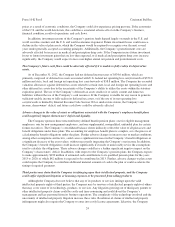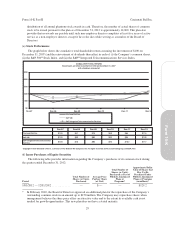Cincinnati Bell 2012 Annual Report Download - page 94
Download and view the complete annual report
Please find page 94 of the 2012 Cincinnati Bell annual report below. You can navigate through the pages in the report by either clicking on the pages listed below, or by using the keyword search tool below to find specific information within the annual report.and vandalism, and have disaster recovery plans available for disruption of services. The failure to address these
or other events may result in a disruption of services. In addition, any inability to meet service level
commitments or other performance standards could reduce the confidence of customers and could consequently
impair the Company’s ability to attract and retain customers, which would adversely affect both the Company’s
ability to generate revenues and operating results.
A few large customers account for a significant portion of the Company’s revenues and accounts receivable.
The loss or significant reduction in business from one or more of these large customers could cause operating
revenues to decline significantly and have a materially adverse long-term impact on the Company’s business.
As of December 31, 2012, the Company had receivables with one large customer that exceeded 10% of the
Company’s outstanding accounts receivable balance. Contracts with customers may not sufficiently reduce the
inherent risk that customers may terminate or fail to renew their relationships with the Company. As a result of
customer concentration, the Company’s results of operations and financial condition could be materially affected
if the Company lost one or more large customers or if services purchased were significantly reduced. If one or
more of the Company’s larger customers were to default on its accounts receivable obligations, the Company
could be exposed to potentially significant losses in excess of the provisions established. This could also
negatively impact the available capacity under the Receivables Facility.
The Company depends on a number of third-party providers, and the loss of, or problems with, one or more of
these providers may impede the Company’s growth or cause it to lose customers.
The Company depends on third-party providers to supply products and services. For example, many of the
Company’s information technology and call center functions are performed by third-party providers, and network
equipment is purchased from and maintained by vendors. In addition, almost half of the wireless towers used by
CBW are managed by a single independent service provider. Any failure on the part of suppliers to provide the
contracted services, additional required services, or additional products could impede the Company’s business
and cause financial results to suffer.
A failure of back-office information technology systems could adversely affect the Company’s results of
operations and financial condition.
The efficient operation of the Company’s business depends on back-office information technology systems.
The Company relies on back-office information technology systems to effectively manage customer billing,
business data, communications, supply chain, order entry and fulfillment and other business processes. A failure
of the Company’s information technology systems to perform as anticipated could disrupt the Company’s
business and result in a failure to collect accounts receivable, transaction errors, processing inefficiencies, and the
loss of sales and customers, causing the Company’s reputation and results of operations to suffer. In addition,
information technology systems may be vulnerable to damage or interruption from circumstances beyond the
Company’s control, including fire, natural disasters, systems failures, security breaches and viruses. Any such
damage or interruption could have a material adverse effect on the Company’s business.
The business could be negatively impacted by cybersecurity threats.
Cybersecurity threats could adversely affect the wireline or wireless networks, the electronic payment
system, or the corporate network. Such threats could result in disruption of customer service, unauthorized access
to or misappropriation of confidential customer data, or damage to our internal network. Preventative measures
in place to mitigate such risks include use of dedicated private networks, strong user names and passwords,
intrusion protection systems, anti-virus software, and encryption and authentication technology. Weekly system
scans are performed on the most critical systems to identify potential vulnerabilities. These events could disrupt
operations, result in a loss of customers, lead to adverse publicity, or require significant amounts of capital to
remedy the cybersecurity breach.
20
Form 10-K Part I Cincinnati Bell Inc.


